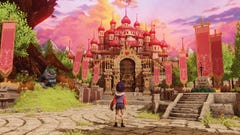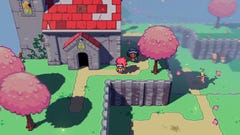Coffee Talk Episode 2: Hibiscus and Butterfly review - a little less refined than the original blend
Here's the tea.
As someone who used to live and die by midnight lattes, playing Coffee Talk was a pleasant jaunt into the past when all I had were college deadlines and a much more resilient body. Now, caffeine after sunset sends me into a sweaty pain spiral, so it was easy to get sentimental over a game centered on sitting over a cozy brew in the dead of night. This charm and simplicity drew me in quickly, and the second chapter, Coffee Talk Episode 2: Hibiscus and Butterfly, is more of the same: the player is the enigmatic barista (and ostensibly owner) at Coffee Talk, a tiny cafe that only opens at night, and makes comforting drinks while listening to customers talk about their problems.
The game begins several years after the end of the first, and features previous regulars like neighborhood police officer Jorji and lifelong best friends Hyde and Gala. It's set in the same supernatural version of Seattle filled with otherworldly creatures, from orcs and satyrs to vampires and gnomes, with a "Main Six" list of recognized races and an excruciatingly slow integration process for other previously "unknown" peoples. Thankfully, Coffee Talk's slice-of-life focus helps it avoid the worst pitfalls of hackneyed fantasy-race stereotypes, as characters deal with relatable personal crises on a much smaller and intimate scale than, say, a hundred-year war between orcs and elves. For instance, a socially awkward banshee named Riona harbors dreams of becoming a soprano in an opera scene dominated by sirens, and the ever-exhausted Jorji will vent about his home life and relationship with his family.
The subtitle comes from two new teas - hibiscus and blue pea (also known as butterfly pea) flower - which are required to make new drinks like Zobo from Nigeria, or Teh Jahe Rosella from Toge Productions' home base of Indonesia. Unlike the first game which was purely drink-mixing and dialogue, this time the player also receives objects left in the cafe and must give them to the appropriate person the next time they come in; the player only gets one chance to hand over an item while serving said person their drink, which is stupidly easy to forget, and with a couple of exceptions, has no real impact on major character arcs. Objects also disappear after a certain number of days. Failing to give Riona another character's contact information, for instance, is a non-negotiable part of the main narrative, so she'll get hold of it despite the player's forgetfulness
Mixing drinks - the most interactive portion of the game - is a straightforward process of combining three ingredients in order. There's a base, primary, and secondary ingredient, but I occasionally found some of the combos to be impossible - Lucas, at one point, asks for a pumpkin spice latte surrogate, but at no point does the barista have anything remotely close to a pumpkin or even a gourd-like fruit in their arsenal. After randomly googling one of the other drinks, I stumbled across a potential solution quite by accident. The latte art mechanic still remains a special hell where hand-eye coordination goes to die - my multiple attempts at scrawling a heart were worse than what I drew when I was a toddler. I blame this on my Joycons, but my experience using a keyboard and mouse in the first Coffee Talk were almost as bad. If this is a pointed hint to tip your baristas more when they give you latte art, it's working.


It feels weird to complain that a game structured around everyday vignettes doesn't feel as cohesive as its predecessor, especially with the understanding that games are arguably one of the most effective mediums to subvert conventional expectations of what a "story" should look like. Perhaps it's because the first game had a consistent throughline in the form of Freya, the green-haired writer whose arc was integral to helping the player form a bond with the game; Hibiscus and Butterfly leans more on the ensemble cast of multiple regulars, which has a drastically different feel. For the most part, the writing hews to the same tone as the first game - a generally smooth blend of banter, well-defined characterization, fantasy Seattle-specific colloquialisms, and a touch of formality on the barista's part.
Hibiscus and Butterfly, though, has a noticeable share of stiff dialogue, filler, and unwieldy chunks of exposition, which, while unavoidable due to the nature of the visual novel format, could use more polish. The saving grace here was the genuine affection I have for the four of the main regulars: longtime couple Lua and Baileys, and old friends Hyde and Gala. More than anything, it's this comfortable familiarity that defined my Hibiscus and Butterfly playthrough, whether it was Lua's very welcome first appearance in the game, or pairing any of the old regulars with the (at times, rather frustrating) newcomers to create a warm sense of belonging. Jorji's storyline about a vandalism case-turned-history lesson was patchy at best, and featured a truly baffling interaction with random other cops who preach empathy and compassion. My best guess here is that the writers were trying to humanize individuals in law enforcement, which is a weirdly disjointed thing to push into a game explicitly about not policing race and identity against a backdrop of virulent anti-immigration and tech-enabled racism.




Coffee Talk's fiercest appeal to me was its simplicity, carefully building on layers of nostalgia and fantasy not just for an old-school coffee shop where the barista doubles as local everyfriend and therapist, but a north star in a time when the traditional brick-and-mortar third place - a public, community-oriented space that fulfils specific social roles - is an endangered concept. The internet and social media has become a surrogate for many of these old interactions, and the characters in the game use a social media app called Tomodachill to post "stories" that the player can like (with no discernible effect on gameplay). It became such a nightly source of low-stakes pleasure that I could easily overlook some of the more uneven writing and tedious bits to unwind with familiar faces and go through the motions of helping my little flock of customers.
Games-as-a-third-place isn't a new comparison - MMOs are probably the clearest examples of virtual spaces where people have formed low-key, low-stakes hangouts that revolve around chat. I'm not talking about doing combat-intensive raids or high-level instances, but more along the lines of Final Fantasy XIV housing roleplayers who create cute little cafes with other players (and bathhouses, and brothels, and so on). This is all, of course, player-made content, driven by groups of players within the confines of the game's parameters. And while there are other lowkey hangout visual novels that focus on conversations and low (or no) stake conflict, Coffee Talk is devoid of gimmicks and simply has a reliable, well-executed formula: an exceedingly chill soundtrack, relatable drama with occasionally sobering outcomes, earnest if not occasionally awkward attempts to give its characters meaningful social and political context, and an innate understanding of the unavoidably human need to be heard.
The whole Coffee Talk series is, on the most obvious surface-level reading, a narrative love letter to the third place, but with a little behavioral twist - it encourages (rather meta) return patronage in the form of the player loading up the game to seek a rare form of connection through its characters: the exceptional moments in time when strangers (or strangers who get off on the wrong foot) can keep it together long enough for a spark of friendship to form. Like the first Coffee Talk, Hibiscus and Butterfly winds down with the understanding that there isn't really ever an end, and the night owl in me is glad.














